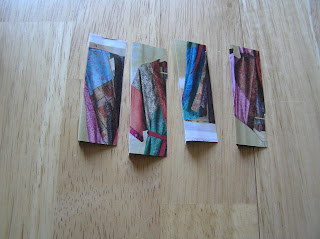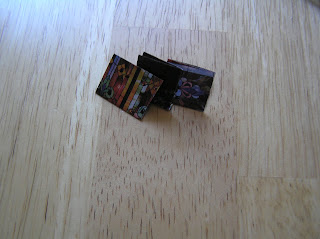Tutorial
Another Christmas Card Made from Junk Mail (this tutorial is for the wreath on the left)
Materials
Thick paper for the card (I used 67 lb cover stock)--one large piece and one half its size
Junk Mail, magazine, used wrapping paper, or any pretty paper
Scotch tape
Glue
Scissors
String
Color pencil
Compasses, bowl or some circular object for drawing a circle
Time Taken
1 hour
General Idea
Cut a circular shape out of the frame, like a round Christmas ornament, or a wreath. Tape strips of junk mail to the underside of the frame in a circular fashion.
Instructions
Step 1 and 2) Same as in Tutorial 2.
Step 3) Draw a circle on the half sheet of card stock (I will call this the frame). Make sure the circle is centered horizontally.
Step 4) Draw lines right through the diameter of the circle, at regular intervals. I used compasses to space the lines so that each pair of adjacent lines formed a 30-degree angle. You can just eyeball the position of the lines if you don't have compasses or a protractor.
Step 5) Draw as big a circle as will fit onto the card, with the same center as the existing circle, ie you will have 2 concentric circles. This step is done only to improve the speed at which you can tape the strips on.
Step 6) Cut the smaller circle out.
Step 7) Number the lines in a counterclockwise manner. It doesn't matter where you start numbering. Whether you number the lines in a counterclockwise manner or clockwise manner doesn't matter, just choose a direction and number them.
Step 8) Cut 12 strips of junk mail, about 1.5" by 3". Fold a raw edge of each strip to the wrong side.
Step 9) Tape a folded strip so that its folded edge crosses:
the intersection of #1 and the outer circle
the intersection of #6 and the outer circle
Trim the strip so that you can see where each of the lines crosses the outer circle


Step 10) Tape a folded strip so that its folded edge crosses:
the intersection of #12 and the outer circle AND
the intersection of #5 and the outer circle
Trim the strip so that you can see where each of the lines crosses the outer circle
Step 11) Continue taping strips in a clockwise manner, trimming the access. Whether your taping in a clockwise manner or counter clockwise manner does not matter, just make sure to choose one direction and stick with it. As you are taping the last few pieces, you will need to overlap pieces so that the design is consistent.
Step 12) Make sure the design looks regular from the front of the frame. Trim off any pieces that are jutting out of the edge of the frame.
Step 13) Glue the frame to the front of the card.
Step 14) Tie a piece of ribbon into a bow and glue it to the bottom of the wreath.





































